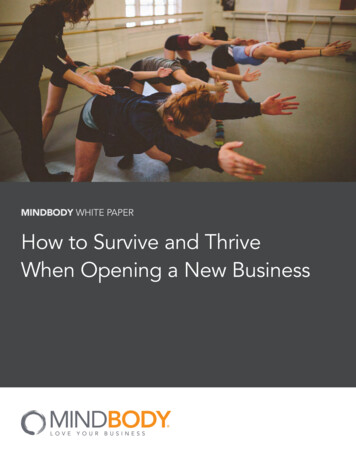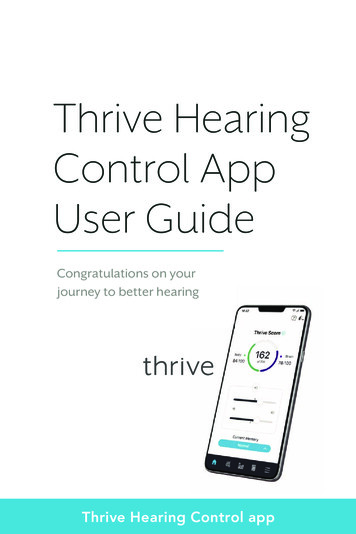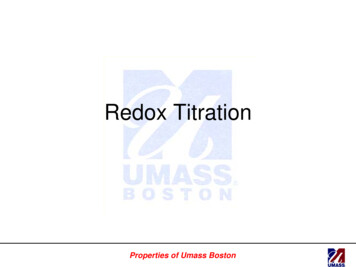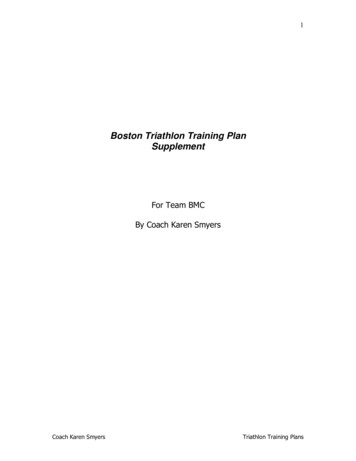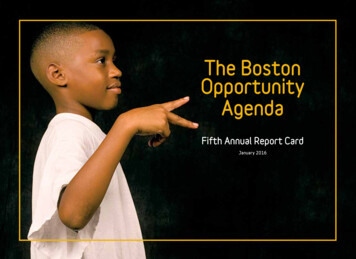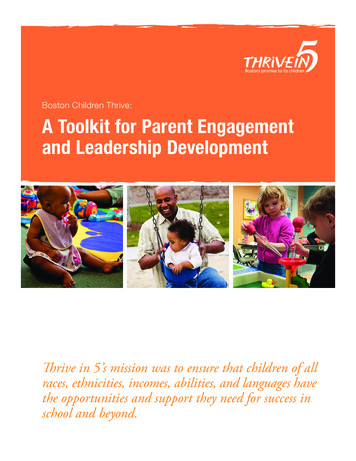
Transcription
Boston Children Thrive:A Toolkit for Parent Engagementand Leadership DevelopmentThrive in 5’s mission was to ensure that children of allraces, ethnicities, incomes, abilities, and languages havethe opportunities and support they need for success inschool and beyond.
Table of Contents2IntroductionWhat Was Thrive in 5?What Were Thrive in 5’s Key Strategies?4Boston Children ThriveWhat Was Boston Children Thrive?How Were Hub Agencies Selected?How Did Thrive in 5 ImplementBoston Children Thrive?What Is the Boston FamilyEngagement Network?What Is Screen to Succeed?8Parent Leadership PathwayWhat Is the Parent Leadership Pathway?Why Parent Partners?What Is the Role of Parent Partners?What Are Lessons Learned From theParent Leadership Pathway?What Are Some Challenges of theParent Partner Model?Will the Parent Leadership PathwayBe Sustained?21AcknowledgementsAppendixAdditional Success StoriesTHRIVE IN 5 thrivein5boston.orgINTRODUCTIONThis Toolkit was developed to provide materials,implementation details, and lessons learned aboutThrive in 5’s parent leadership model. The Toolkitdescribes key features of Thrive in 5’s approach toparent leadership in two of its strategies, BostonChildren Thrive (BCT) and Screen to Succeed (STS).The Toolkit was developed with support from the BarrFoundation. The tools and materials in this Toolkitmay be reproduced and used or adapted, but weask that you identify this Toolkit as the source.Suggested citation: Thrive in 5. 2016. BostonChildren Thrive: A Toolkit for Parent Engagementand Leadership Development. Available atthrivein5boston.org/resources.Please note that while Thrive in 5 ended as a formalinitiative in June 2016, many of the components ofBoston Children Thrive have been integrated intoagency practices and will continue on in the community. Screen to Succeed and components of BostonChildren Thrive will continue at the United Way ofMassachusetts Bay and Merrimack Valley (UnitedWay) through the DRIVE (Data and ResourcesInvesting in Vital Early Education) initiative.Thrive in 5 would like to acknowledge all of theBoston Children Thrive, Boston Family EngagementNetwork, and Screen to Succeed agency partners,including all staff and Parent Partners. Your strongleadership and collaboration has pushed the boundaries of family engagement work in Boston and ledto authentic culture and systems change. We alsowish to thank Randi Freundlich and Samilla Quiroa,who conducted all of the interviews with agency staffand Parent Partners, which formed the basis of thistoolkit. For the full list of partners, please seepage 21.2
What Was Thrive in 5?What Were Thrive in 5’s Key Strategies?Thrive in 5’s mission was to ensure that children ofall races, ethnicities, incomes, abilities, and languageshave the opportunities and support they need forsuccess in school and beyond. In partnership withthe City of Boston and United Way of MassachusettsBay, Thrive in 5 fostered collaboration among allof the critical people in a child’s life — parents, earlyeducation and care providers, teachers, and healthand human services system professionals — tocreate an environment that ensures every child hasthe opportunities and support they need for successin school and in life. Launched in 2008, Thrive in5 worked to build community capacity to supportschool readiness, strengthen the quality of existingservices, expand and create programs to addressunmet needs, and measure progress to ensureaccountability.Thrive in 5 had several main strategies to accomplishthese goals.Ready FamiliesA family that is in the strongest position to supporttheir child’s learning and development; achievedthrough Boston Children Thrive (BCT), an innovative community and family engagement model intargeted neighborhoods.Ready EducatorsHigh-quality, well-aligned early childhood care andeducation; achieved through Ready EducatorsQuality Improvement Project and Boston K1DS,which focused on quality improvements in earlyeducation and care settings throughout the city.Ready SystemsProactive, coordinated systems (health care, earlyintervention, social services, and others) that promote school readiness through early screening andintervention; achieved through Screen to Succeed,which aims to establish universal developmentalscreening of young children across Boston.Ready CityA city that makes school readiness a civic priority.THRIVE IN 5 thrivein5boston.org3
BOSTON CHILDREN THRIVE (BCT)What Was Boston Children Thrive?Boston Children Thrive (BCT) served as the “ReadyFamilies” strategy of Thrive in 5 with support fromthe W.K. Kellogg Foundation. BCT was a neighborhood-based initiative that built community capacityto empower and engage families in their children’slearning and healthy development, starting at birth.A major BCT goal was to reach and engage familieswho are likely to be disconnected from services tosupport their children’s development and schoolreadiness. The target population included low-incomefamilies, families of color, immigrant families, andfamilies whose first language is not English. Hubagencies in each neighborhood led the BCT effort.Please see the BCT Overview and BCT logic model.How Were Hub Agencies Selected?The selected hub agencies were chosen as a resultof an open, competitive process, including comprehensive responses to a Request for Proposals(RFP) and site visits. The selected hub agencies whooriginally led the BCT work included a communityhealth center, a community organizing neighborhood initiative, family support agencies, and agenciesproviding childcare. The hubs have become stronglead agencies for implementation of Thrive in 5’soverall strategies in the community.How Did Thrive in 5 Implement BostonChildren Thrive?Although the implementation and programming ofBoston Children Thrive (BCT) was unique to eachneighborhood, the BCT model contained these corecomponents across the city:In 2010, hub agencies in five neighborhoods in Boston were chosen to receive funding and implementthe BCT work in their communities: A hub agency (lead agency) in each neighborhood responsible for convening, organizing, andproviding a backbone structure for local efforts. Allston-Brighton (Family Nurturing Center); East Boston (East Boston Social Centers); Fields Corner, Dorchester (DotHouse Health); Roxbury/Dudley (Dudley Street NeighborhoodInitiative); South End/Lower Roxbury (United South EndSettlements). In 2014, South Boston joined the BCT initiative(South Boston Neighborhood House) withsupport from the Herman and Frieda L. MillerFoundation.Parent Partners (parent leaders), the face ofBCT on the ground. Parent Partners are parentsand caregivers from the neighborhood who arestipended to conduct peer-to-peer outreach withethnically and linguistically diverse communities.Parent Partners also take an active role in determining appropriate programming and supporting its implementation. As part of Thrive in 5’sScreen to Succeed initiative, Parent Partnershave been trained to administer the Ages andStages Questionnaire (ASQ) to families whoseyoung children were not in an early educationand care setting (Please see page 6 for moreinformation on Screen to Succeed). Parent Partners serve as connectors, building relationshipsbetween isolated families and community-basedorganizations, and leading activities that engagefamilies in culturally-responsive activities tosupport children’s development.These neighborhoods were selected because theyhave both strong networks of support and high concentrations of families with young children leastconnected to early childhood and family services.THRIVE IN 5 thrivein5boston.org4
School Readiness Roundtable (SRR), a leadership board comprised of partnering agencies,parent leaders, and other key stakeholders.The SRRs in each neighborhood create andimplement an aligned neighborhood networkof resources and supports for families and caregivers. In each neighborhood, Boston ChildrenThrive is led by this coalition of parents, earlyeducation programs, libraries, health and socialservice providers, businesses, and other stakeholders who meet monthly to design and implement strategies to connect families to existingresources, create new opportunities, and alterservices to better meet families’ needs. An array of programs for families that build afoundation of enriching, developmentally-appropriate activities and events in the community forfamilies with young children. By participatingin these activities, children have access to thehigh quality experiences needed to promotetheir healthy development, parents gain theknowledge and skills to support their child’searly learning, and families develop critical socialconnections to one another, neighborhood organizations, and the broader community. Althoughprograms vary from community to community,some core activities included playgroups, fieldtrips, family nights, parent trainings and workshops, and home visits to newborn babiesthrough a Boston program, Welcome Baby.1 A membership card system (launched in 2012),where a free membership card with a bar codefor each adult caregiver was issued to participating families. The card was designed to bescanned when families participated in plannedactivities. The membership card system willcontinue at United Way as part of the DRIVEinitiative, and it will transition to a mobile application, through a partnership with SchoolCNXT2THRIVE IN 5 thrivein5boston.orgthat is launching during summer, 2016. Themobile application allows families to view nearbyevents, register and sign in to those events, andearn and track their participation points. A learning community, comprised of hubagency and parent representatives from eachneighborhood, met regularly during the firstthree years of BCT to share learnings andpromote cross-community actions. Parent-led projects, some of BCT’s mostengaging and popular activities were designedand led by parents themselves. Parents in theneighborhood identified gaps in programming,completed an application with a work plan andbudget, and were granted funds to plan andimplement new projects and activities, suchas a new playgroup or workshop that met thelanguage and cultural needs of an underservedcommunity. The Parent Leadership ProjectGuidelines can be found here. Thrive in 5 andthe Boston Family Engagement Network sponsored neighborhood-based teams of parentleaders who planned and implemented activitiesin their community that address the real needsand challenges of local families. Through theprocess, parent leaders support one anotheras they develop valuable skills in communityorganizing, planning, budgeting and advocacy,as well as build their network of contacts inthe community.1 The Welcome Baby program, developed by the Family Nurturing Center, offersa celebratory home visit to families with newborns. Visitors bring a gift bag forthe family, and share information about activities, resources and services in thecommunity. It’s also an opportunity to promote literacy and reinforce theimportance of reading in child development and school readiness.2 SchoolCNXT is a flexible, mobile/web-based parent engagement platform thatconnects parents, teachers, students, and administrators, providing an efficientand effective way to share news and important information; send reminders;and create an engaged, connected community. To learn more aboutSchoolCNXT, please visit www.schoolcnxt.com.5
BOSTON FAMILY ENGAGEMENT NETWORK COORDINATOR:“We’ve been moving towards, ‘Where are the parentinterests, where do their strengths lie, and how can weintegrate them into the work?’ It’s been a way to makesure that parents are still in leadership and decision–making roles, but also integrated into other parts ofwhat’s happening.”Each hub agency, with input from their SRR, washeld accountable for community planning in theirneighborhood. The planning tool can be found here.What Is the Boston Family EngagementNetwork (BFEN)?The Boston Family Engagement Network (BFEN)is a citywide coalition focused on raising awarenessabout the importance of family engagement in thelife of a young child. It is comprised of parents,community partners, early educators and familysupport workers who are invested in ensuring thatbeginning at birth, all young children have access toa quality educational experience whether at home,in school, or in child care. BFEN’s work is fundedby the Massachusetts Department of Early Education and Care’s Coordinated Family and CommunityEngagement (CFCE) Grant. All services are free ofcharge to families.What Is Screen to Succeed?Screen to Succeed is a groundbreaking initiative forachieving universal child development screening foryoung children in the city of Boston. Understandingchildren’s developmental progress — individuallyand citywide — creates opportunities for preventionand intervention in the critical “brain building” phaseof a child’s life, when services are more effective andless costly. The data collected through Screen toSucceed allow families, teachers, health providers,and the city to take a data-driven approach to earlychildhood, making informed, strategic decisions totailor support and resources to the children, families,and communities that need them most. Screen toSucceed will continue its efforts to achieve universaldevelopmental screening through the DRIVE (Dataand Resources Investing in Vital Early Education)initiative at United Way. Key elements of Screen toSucceed include:BFEN began a close collaboration with Thrive in 5as the BCT work took hold. The BCT hub agencystaff and staff from BFEN-funded agencies acrossBoston met on a bimonthly basis to align their work.Seeing the benefits of Parent Partners to BCT hubagencies, BFEN adopted the Parent Partner modeland began to allocate specific funding for this work.The BFEN coordinator felt that parent leaders werevery important.THRIVE IN 5 thrivein5boston.org6
Peer-to-Peer Parent Screeners:Based on the BCT Parent Partner model,Screen to Succeed utilize
Massachusetts Bay and Merrimack Valley (United Way) through the DRIVE (Data and Resources Investing in Vital Early Education) initiative. Thrive in 5 would like to acknowledge all of the Boston Children Thrive, Boston Family Engagement Network, and Screen to Succeed agency partners, including all staff and Parent Partners. Your strong leadership and collaboration has pushed the bound-aries of .

